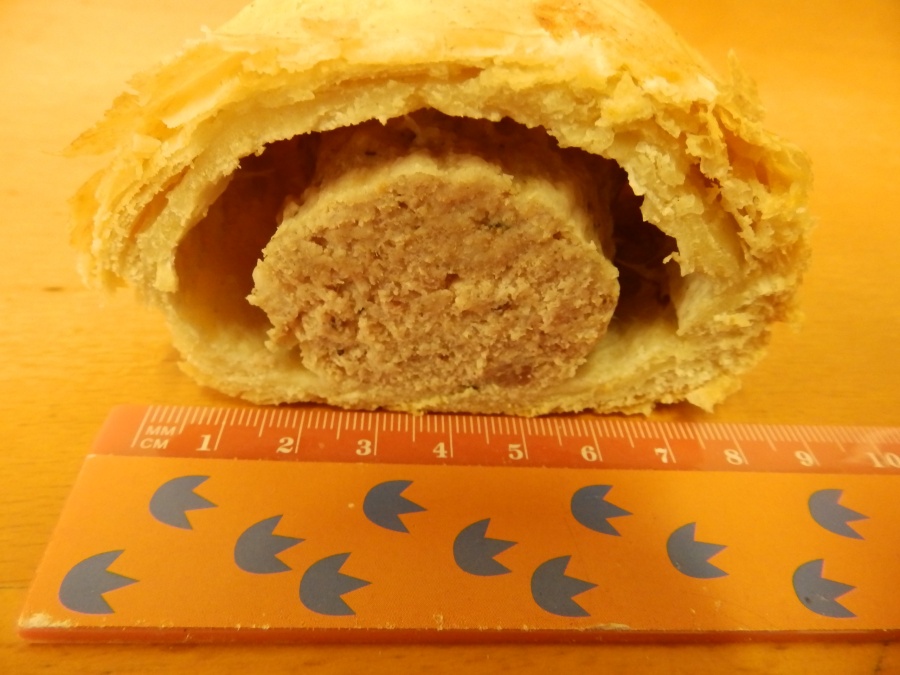I couldn’t make my mind up in the supermarket, so we’ve ended up with a veritable buffet of TESCO mini-sized pork pies. I think these are the ones that used to be called bite-sized, but that’s a stretch even for me, despite the big mouth and bad manners.
There is Pork and Apple, Pork and Pickle and New York Deli.
The Pork and Apple, is made with diced apples, according to the front label, and apple sauce and diced apple according to the back of the packet. It’s a very good mass-produced pie. The pastry has a bit of a crunch to it, the meat has a good flavour, there is a little jelly and when you’ve finished one, you would like another. Compared to the Sainsbury’s Pork and Apple pie I tested previously this one scored equally on flavour but lost a bit on texture. It has jelly and a peppery after-taste, which are plus points, but I didn’t think the pastry or overall experience was quite as good. But as I say, it did have jelly.
For that reason I think a 6/10 is fair.
Take that as a lesson Sainsbury’s – you leave out the jelly at your peril.

TESCO Pork and Apple Pie

TESCO Pork and Apple Pie
The Pork and Pickle was better than I expected, though that isn’t saying much. The taste suffered from the Branston style pickle – I’m now a convert to a wider range of chutneys and standard Branston seems a bit basic. Even when I was a Branston fan I never really liked it in a pie. I’m not even sure how I really feel about any chutney included in a pie. On a pie yes, but in one? Really?
To add to my annoyance the pack includes a totally superfluous notice telling me that the pie is ready to eat.
The pastry was OK. The flavour was not improved by the pickle, and nor was the texture which was too soft. I couldn’t see any jelly (though the ingredients list include pork gelatine) but the pickle, to be fair, did add the moisture that the jelly would have done. On balance, it could have been a lot worse. I remember some harrowing pies in the past when I first tried pork and pickle, but even so, a good pork pie with a nice pickle on the side is always going to beat a mongrel mixture like this.
If I put my prejudice about pickle in pies to one side (though I’m not sure I have too when you look at the blog title) it’s still only 4.5/10.

TESCO Pork and Pickle Pies

TESCO Pork and Pickle Pies
Finally, the New York Deli pork pie. It was news to me that there was such a thing. Nobody in New York appears when I searched the internet for it. The only mention of a New York Deli in the first two pages of a Google search features a chicken pot pie, which is not the same thing at all. The majority of mentions are about the TESCO pie, including someone on a chat forum praising them in relation to “turgid” ordinary pork pies.
There is also a rebuttal by someone else, pointing out the pie’s poor showing at the British Pie Awards. I’m going to write a post on the content of chat rooms one day – working title Knee Deep in Nerds.
I’m divided on the issue. The flavour of pastrami comes through and I suppose it could be pleasant, I’m just not sure. I don’t see what link there is between pork pie and pastrami or pork pies and New York. By all means make a pie with pork, mustard and beef, but why call it a pork pie?
The competition entry pictured here at the British Pie Awards is a far cry from a pork pie with a bit of flavouring. I can admire a pie with a massive streak of beef down the middle, but I’m not so sure about a weaselly snack pie with a suggestion of beef. And then we come to the gherkin…
In the first pie I sampled the large piece of gherkin came as a bit of a shock. Even now the taste has subsided I still feel the betrayal. The second wasn’t much better, it had lightly smaller pieces but retained a sense that something bad was about to happen.
Crust was OK, texture of filling OK, even the flavour, though I struggled slightly. It is more to do with marketing than a natural marriage of flavours. The massive slap of gherkin, though, that has cost you TESCO.
4/5 for an unnatural pie. It was not as bad as I thought, but then the gherkin hit.

Can you see the gherkin?

New York Deli Pork Pie





























